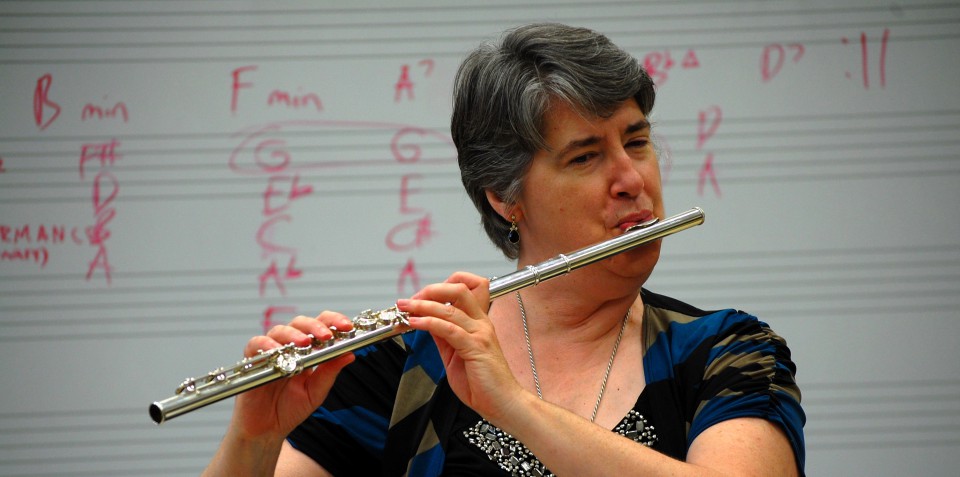Tags
Woodwind players, but especially flutists, have to deal with a lot more ornaments earlier on in their playing experience than brass or percussion instruments. There are a number of symbols that are very useful to know about so you can help your students learn to properly execute these ornaments.
Let’s start with trills. By far the most common ornament in flute music. You will see trills in band repertoire, flute literature from all musical periods and small ensemble music. First of all, you always trill upwards, always. How do you know what note to trill to? You trill to the next note above in the key. This can be a half step or whole step. There is one big caveat. If there is an accidental next to the tr symbol, the accidental supersedes the key signature and you trill up to that note instead. In flute specific repertoire, there is another caveat for music written before approximately 1800. It is frequently correct to start the trill from the auxiliary note above the note being trilled whether or not there is a written appoggiatura (small grace note without a slash). Your students unlikely to see this in band literature, but in solos, etudes and chamber music.
Trills often use what would normally be considered cheats or fingering shortcuts. It’s important to emphasize to your students that they need to look the fingering up if they are not sure how to correctly execute it. Lots of kids think trilling is just about wiggling an adjacent finger, whether it is to the correct fingering or not. Make them look it up. With everyone having a device in their pocket these days, there is no excuse for not having the correct fingering for trills. My go-to site for all things fingering, including trills, is the Woodwind Fingering Guide. There is also now a free app for flute players that is really complete for standard, alternate and trill fingerings called Fingercharts.

This example from an Andersen etude has three very common ornaments, namely grace notes (the little notes with slashes through the stem), turns a.k.a. gruppettos (looks like a letter “S” on its side) and mordents (a short jagged line above the note). Grace notes come immediately before the note it ornaments and actually steal just a small fraction of the value of the note preceding the note with the grace note. Play them as close to the note it ornaments as possible. In music before about 1800, the graces fall on the beat and steal a small amount of value from the ornamented note. Mordents are no big deal. Essentially they are a one wiggle trill, up and back down very quickly.
Turns are the most complex of these common ornaments. At the simplest, they consist of the note being ornamented, the upper neighbor, the note and the lower neighbor before exiting to the next written note. The complexity lies in using the correct rhythm. A simple example would be:
Here is an example with a mordant and a turn in another Andersen etude. Note that when the turn falls inside a dotted rhythm, it usually is executed with a triplet. Also note that the sharp under the turn symbol means to raise the lower neighbor half a step. An accidental under the turn means alter the lower neighbor. An accidental above the turn means alter the upper neighbor.

The last ornament we are going to look at is the appoggiatura. In music especially from the Baroque and Classic Periods, there are frequently small notes that look remarkably like grace notes with one distinguishing difference. There is no slash through the stem. Especially common in the music of Mozart and Haydn, you also occasionally run across appoggiaturas in music from the 19th century. The main thing that distinguishes appoggiaturas from regular grace notes is that the appoggiatura subtracts value from the note it ornaments. In this example from the Mozart Concerto in G major, this passage is played as straight 16ths, slur two, tongue two.

Finally, in this example from an etude by Kummer, there is a turn following a dotted half note, executed as a half note with a 16th note turn, followed by a half note appoggiatura. Play the appoggiatura as a half note followed by a quarter note.
If you find these entries useful, please subscribe, share with your colleagues and come back regularly for more flute tips. Feel free to comment. If you have a topic you would like to see explored more fully, you can contact me via IM/Messenger on Facebook or email me at dr_cate@sbcglobal.net. For information about clinics and workshops click here.

Hello Dr Hummel
Very interesting page. Could you please give me the name of the Andersen etude, so I can practice it? Thank you!
LikeLike
The etudes cited in this article are Andersen Op. 15 no. 6, Andersen Op. 21 no.10 and Kummer Op. 110 no. 17. They are all available from IMSLP.org
LikeLike